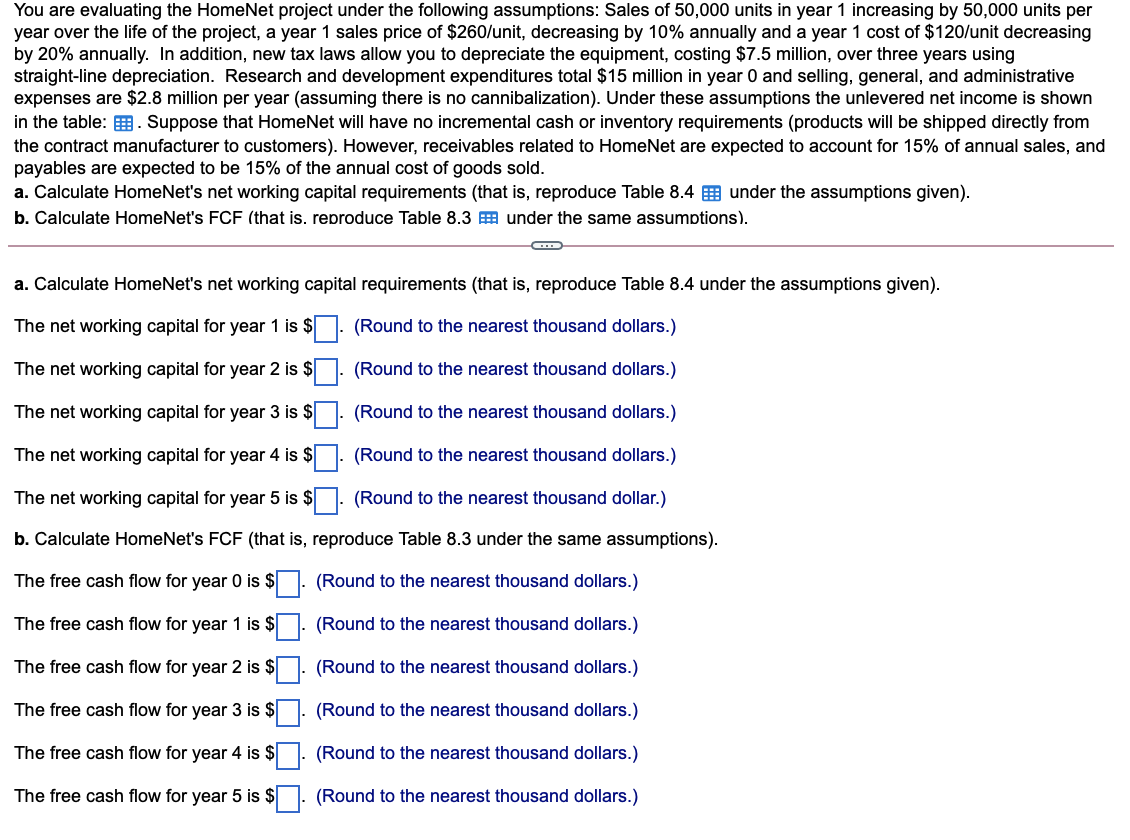
You are evaluating the HomeNet project under the following assumptions: Sales of 50,000 units in year 1 increasing by 50,000 units per year over the life of the project, a year 1 sales price of $260/unit, decreasing by 10% annually and a year 1 cost of $120/unit decreasing by 20% annually. In addition, new tax laws allow you to depreciate the equipment, costing $7.5 million, over three years using straight-line depreciation. Research and development expenditures total $15 million in year 0 and selling, general, and administrative expenses are $2.8 million per year (assuming there is no cannibalization). Under these assumptions the unlevered net income is shown in the table: . Suppose that HomeNet will have no incremental cash or inventory requirements (products will be shipped directly from the contract manufacturer to customers). However, receivables related to HomeNet are expected to account for 15% of annual sales, and payables are expected to be 15% of the annual cost of goods sold. a. Calculate HomeNet's net working capital requirements (that is, reproduce Table 8.4 e under the assumptions given). b. Calculate HomeNet's FCF (that is, reproduce Table 8.3 B under the same assumptions). O a. Calculate HomeNet's net working capital requirements (that is, reproduce Table 8.4 under the assumptions given). The net working capital for year 1 is $ (Round to the nearest thousand dollars.) The net working capital for year 2 is $ (Round to the nearest thousand dollars.) The net working capital for year 3 is $ (Round to the nearest thousand dollars.) The net working capital for year 4 is $ (Round to the nearest thousand dollars.) The net working capital for year 5 is $ (Round to the nearest thousand dollar.) b. Calculate HomeNet's FCF (that is, reproduce Table 8.3 under the same assumptions). The free cash flow for year 0 is $ (Round to the nearest thousand dollars.) The free cash flow for year 1 is $ (Round to the nearest thousand dollars.) The free cash flow for year 2 is $| (Round to the nearest thousand dollars.) The free cash flow for year 3 is $ (Round to the nearest thousand dollars.) The free cash flow for year 4 is $ (Round to the nearest thousand dollars.) The free cash flow for year 5 is $| (Round to the nearest thousand dollars.) You are evaluating the HomeNet project under the following assumptions: Sales of 50,000 units in year 1 increasing by 50,000 units per year over the life of the project, a year 1 sales price of $260/unit, decreasing by 10% annually and a year 1 cost of $120/unit decreasing by 20% annually. In addition, new tax laws allow you to depreciate the equipment, costing $7.5 million, over three years using straight-line depreciation. Research and development expenditures total $15 million in year 0 and selling, general, and administrative expenses are $2.8 million per year (assuming there is no cannibalization). Under these assumptions the unlevered net income is shown in the table: . Suppose that HomeNet will have no incremental cash or inventory requirements (products will be shipped directly from the contract manufacturer to customers). However, receivables related to HomeNet are expected to account for 15% of annual sales, and payables are expected to be 15% of the annual cost of goods sold. a. Calculate HomeNet's net working capital requirements (that is, reproduce Table 8.4 e under the assumptions given). b. Calculate HomeNet's FCF (that is, reproduce Table 8.3 B under the same assumptions). O a. Calculate HomeNet's net working capital requirements (that is, reproduce Table 8.4 under the assumptions given). The net working capital for year 1 is $ (Round to the nearest thousand dollars.) The net working capital for year 2 is $ (Round to the nearest thousand dollars.) The net working capital for year 3 is $ (Round to the nearest thousand dollars.) The net working capital for year 4 is $ (Round to the nearest thousand dollars.) The net working capital for year 5 is $ (Round to the nearest thousand dollar.) b. Calculate HomeNet's FCF (that is, reproduce Table 8.3 under the same assumptions). The free cash flow for year 0 is $ (Round to the nearest thousand dollars.) The free cash flow for year 1 is $ (Round to the nearest thousand dollars.) The free cash flow for year 2 is $| (Round to the nearest thousand dollars.) The free cash flow for year 3 is $ (Round to the nearest thousand dollars.) The free cash flow for year 4 is $ (Round to the nearest thousand dollars.) The free cash flow for year 5 is $| (Round to the nearest thousand dollars.)







